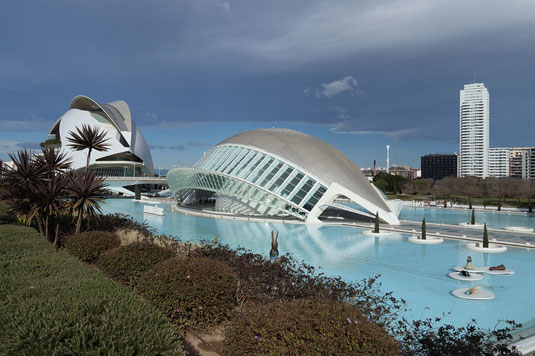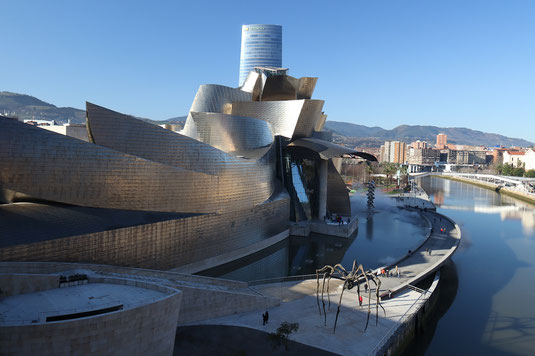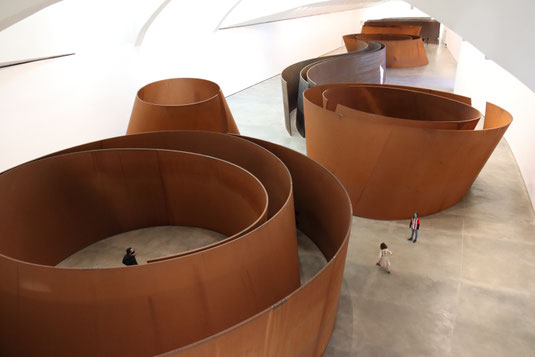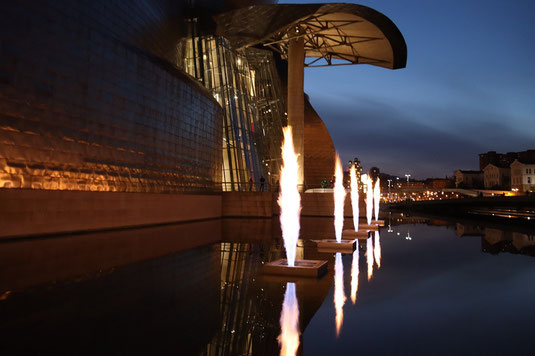Modern Art and the Fire at the Guggenheim - Railtrip Spain II.
27. März 2022

"We're rowing there now," says my boyfriend. I gawk at the turquoise pool of water in front of the futuristic white, seemingly half-sunken L'Hemisfèric building in Valencia. It's January and 72 F. We are on a rail trip through Spain and have just left the wondrous city of Barcelona behind us.
Rowing? On an artificial pond? Why not, actually. We rent one of the small boats and row out onto the tiny, rectangular expanse of water. It's a tourist attraction that is just so dorky that you just have to try it. Especially if you don't know a thing about rowing.
"I want to row, too. Pass the sticks!", I say restlessly. With total a calmness that must have come from heaven, my boyfriend hands me the oars. With the coordination of an octopus after three bottles of gin, we run aground shortly thereafter. Fortunately it's not high season in Spain and nobody sees it happen.
The Ciutat de les Arts i les Ciències, the city of arts and sciences, in Valencia, is a surreal looking complex of art and architecture.
But near the end of our trip, we find an even more uniquely fantastic building and setting: the Guggenheim Museum in Bilbao. There we find a fog sculpture that billows toward us and from which an oversized spider rises. And at night, flames emerge from the fog, shooting upwards.
Come along to the second part of our train journey through Spain. As we leave the classic romance of southern European old-town alleys and begin to explore the wonderful modern art that can be much more fascinating than a meaninglessly daubed canvas that someone bought at auction for $90 million at Sotheby's.
Valencia and the City of Arts

We walk down an avenue of palm trees. I peel myself out of my winter jacket. While an icy wind had been blowing at 40 F in Barcelona, the heat has broken out in Valencia.
I'm not quite sure what the "City of Arts and Sciences" is supposed to be. But that's the exciting thing about traveling. Just go there.
As we arrive, we are standing in front of a series of white cones and arches. And we are also in front of several buildings, one of which sinks into the depths of artificially created water basins. We find an opera, an IMAX cinema, the Science Museum, an Oceanium and a greenhouse without panes. All are part of a long chain of buildings that lie in the drained riverbed of the Turia and are collectively called the "City of Arts and Sciences." That's a typical human endeavor: let's drain a river and then build houses with artificial water basins in it.
Regardless of the irony, it's almost impossible to miss the elegant charm of the snow-white constructions by architects Santiago Calatrava and Félix Candela. Especially L'Umbracle, a series of arches under which palm trees and flowers grow and bloom as if they are in a greenhouse. However, green birds just fly in and out of the structure, and there are no placards describing the plants. It's a crazy illusion because the eye tells you that such a building, or art form, makes no sense without glass windows. As we travel a little further, we find various steel world globes to touch and to turn, so we can grasp the movements of constellations and seasons. Sundials and pendulums abound. I almost freak out from sheer wonderment like Bozo the Clown on old television shows.
Madrid - not convincing

A few days later we are on our way to Madrid. I must confess that I collect European capitals like Easter eggs. Although the short list of can’t-miss sights in Madrid didn't exactly knock me off my stool, I couldn't just go on a train trip around Spain without stopping there.
It is freezing cold. Even my boyfriend, who begins to think about possibly putting on a light jacket in the middle of his 20 F Rocky Mountain winters, has to turn back and put on thicker clothes. Meanwhile, I walk to a Plaza where I sit and wait for a couple of minutes, and I discover two moderately interesting fountains. Later I find out that the square is supposed to be one of the main sights. Mh.
The next morning we go to the Museo del Prado, which is one of the largest art museums in the world. It is scaffolded from the outside and you are not allowed to take photos from the inside. There are lots of paintings of Jesus in all variations, on and off the cross, and fat women. Somehow almost none of it excites me. The Louvre in Paris and the MoMA in New York impressed me more. Finally, we wander into the Retiro Park with its Crystal Palace. Nice. But just nice. Still, without this, Madrid remains in our memory as a rather soulless, modern city with many shopping temples and a lot of noise.
Bilbao: Rise of a city

Our last stop is in Spain is the city of Bilbao. There are few train connections between Madrid and Bilbao. Maybe because Bilbao used to be like the old South Central part of LA used to be, except it is Spain. High unemployment, crime, swamp. But there is hardly any of that left, except in what is called Bilbao’s San Francisco district. The change began in 1997, when the Guggenheim Foundation planted an exciting museum on the city's riverfront. That wasn't the sole reason for Bilbao's transformation into a hip art city, but the crazy, metallic building, somewhat reminiscent of the Sydney Opera House, attracts a million visitors a year. More than three times as many people as live in Bilbao. But before we go in, we are first going to Bilbao’s San Francisco district. That's where our Airbnb is located. Top location, so to speak. I had forgotten to check where Bilbao’s shady areas were before we arrived. Alas.
"So now we're in Bilboa," says my boyfriend as we walk past a roll-up door covered with graffiti. People loiter left and right. Most of them are smoking. Not always cigarettes.
"Bilbao," I say smartly. How does he always come up with Bilboa?
While we walk past yet another group of policemen with guns, I look at the vegetable display in a small store. This is a good place to pick up something for dinner, I think. Then I do what I always do in slightly dubious situations: I pretend that nothing is wrong. And then I leave inconspicuously, but quickly.
After all, the Airbnb is our jackpot. Rustic brick interior walls with ancient wooden pillars in the open middle of the room and a bathtub with a whirlpool function. I love looking behind the facades. It's always different than you think.
Amazing modern art

The Guggenheim Museum is also different. "Modern art," I mutter.
"Maybe we'll just go out again really quick," my boyfriend murmurs. "Then we can go see something else in Bilboa."
Just as we're standing in the entrance showing our online tickets, I have an internal fit of laughter. Bilboa. Rocky Balboa! That's where that came from!
Inside, a video installation lights up in front of us, with red and blue letters forming words running up columns. Then we climb the stairs to the top floor. There is an elevator, but my boyfriend thinks elevators are for losers. And because he is 190 years older than me—give or take—I can't chicken out. At the top, I almost fall into a sculpture because I mistake it for an oxygen tent.
At the Guggenheim Museum, you're allowed to take pictures. With a big, SLR camera. I freak out. Huge paintings by Anselm Kiefer blow me away. But also there are a hundred Marilyns by Andy Warhol, a strange video where something is constantly burning and popping in a Rube Goldberg chain-reaction series, and a dress made of neon tubes that flashes arhythmically every now and then. We also find a wall full of smashed plates and cups doused in paint, hair-thin graphics, treasure chests and deformed disco balls. Modern art. Whoa! Really good.
At the end, we begin to wander through sculptures of thick, giant, steel plates that enclose us and tower above us 24 feet in the air, by the American artist, Richard Serra. I yell "boo" because the echo is so good. Unfortunately, the person coming towards me does not turn out to be my boyfriend.
I pretend that nothing is wrong. And then I walk away, hopefully inconspicuously, but definitely in a quick manner.
Fog and Flames at the Guggenheim Museum

Outside, too, the Guggenheim is amazing. Every hour on the hour during the day, Japanese artist Fujiko Nakaya's fog sculpture spreads across a small manmade pond and nearby river for eight minutes. The tiny droplets that settle on the skin of the face and hands feel cold. Next to the fog installation sits a 30-foot-tall spider "Maman" by Louise Bourgeois, which glows at night on all eight legs. There are also colorful steel tulips, a flower dog and flame throwers. But the flames appear only in the evening after sunset—and only every few minutes for a few seconds.
Although I know about the flames, I wince when they suddenly shoot out of the openings in the water. So loud, so hissing, so seemingly destructive. Just like in the old days when you dropped your Bunsen burner in chemistry class.
Tip: It's best to be there just after sunset, at the top of the hour, and watch the flames together with the mist. Spectacular!
We spent two weeks traveling through Spain by train. The big cities can all be visited that way, and train travel is such a relaxing and relatively inexpensive way to travel.
Here you can find the first part of our trip and more Spain vibes:
- Barcelona and the Architect of Dreams - Railtrip Spain I
- Roadtrip Andalusia - Between Heat, Oceans and Beauty






Lonelyroadlover (Sonntag, 06 März 2022 00:12)
Hi Sarah,
thanks for your comment. We obviously saw different sides of Madrid. I am pretty sure you as a local know the city much better than the standard sightseeing lists on the internet do. Unfortunately the sights you mentioned (Gran Via, Puerta del Sol and so on) are on almost every top 10 list when you search blogs or TripAdvisor for "what to see in Madrid" - and I read more than one to be prepared. Maybe you should put one up with your insiders - that would be cool! Also, art is always a very personal subject. I did see Goya and Velazquez, but I couldn't connect with their style. But I am sure there are people who can appreciate it. Maybe I will be back one day and we can meet for a little city tour. ;)
Greets
Sarah
Sarah (Samstag, 05 März 2022 22:15)
Hi, I'm sorry but if you only saw that in Madrid you were not very well informed about what to see in the city. The Prado is not comparable to the Louvre or the Moma for obvious reasons but going to the Prado and not seeing the paintings of Goya and Velazquez, for example, is a mistake ... if you like modern art, there is obviously the Reina Sofia museum ... do not go to the Gran Via, Puerta del Sol or Plaza Mayor, eat a calamares sandwich .... Malasaña , Huertas, Calamares sandwich, eat cocido ... in short ... and just to give a small example of things to see and do in a short time ...
No acrimony... but MY city is worth to be visited.